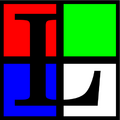Links (web browser)
 | |
 Screenshot of a graphical Links | |
| Developer(s) | Mikuláš Patočka |
|---|---|
| Initial release | 1999 |
| Stable release | 2.29[1] |
| Preview release | None (N/A) [±] |
| Written in | |
| Type | Web browser |
| License | GPL-2.0-or-later |
| Website | links |
Links is a
), supports color and monochrome terminals, and allows horizontal scrolling.It is intended for users who want to retain many typical elements of graphical user interfaces (pop-up windows, menus etc.) in a text-only environment.
The original version of Links was developed by Mikuláš Patočka in the Czech Republic. His group Twibright Labs later developed version 2 of the Links browser, which displays graphics, and renders fonts in different sizes (with spatial anti-aliasing), but no longer supports JavaScript (it used to, up to version 2.1pre28). The resulting browser is very fast, but does not display many pages as intended. The graphical mode works even on Unix systems without the X Window System or any other window environment, using either SVGAlib or the framebuffer of the system's graphics card.
Graphics stack
This section has multiple issues. Please help improve it or discuss these issues on the talk page. (Learn how and when to remove these template messages)
|
The graphics stack has several peculiarities for a web browser. The fonts displayed by Links are not derived from the system,
All graphic elements (images and text) are first converted from a given gamma space (according to known or assumed gamma information in PNG, JPEG etc.) through known user gamma setting into a 48 bits pixel photometrically linear space where they are re-sampled with bilinear re-sampling to the target size, possibly taking aspect ratio correction into account. Then the data are passed through a high-performance restartable dithering engine which is used regardless of monitor bit depth, i.e., also for 24 bits per pixel color. This
Scaled down images also use sub-pixel sampling on LCD to increase the level of detail.
The reason for this high-quality processing is: to provide proper realistic up and downsampling of images, and photorealistic display regardless of the monitor gamma, without color fringing caused by 8-Bit gamma correction built into the X server. It also increases the perceived color depth by over 24 bits per pixel.
Links has graphics drivers for the X Server, Linux framebuffer, svgalib, OS/2 Presentation Manager, and AtheOS GUI.
Forks
ELinks
Experimental/Enhanced Links (ELinks) is a
Hacked Links
Hacked Links is another version of the Links browser which has merged some of Elinks' features into Links 2.
Andrey Mirtchovski has ported it to Plan 9 from Bell Labs. It is considered a good browser on that operating system, though some users have complained about its inability to cut and paste with the Plan 9 snarf buffer.[citation needed]
As of April 2016[update], the last release of Hacked Links is that of July 9, 2003, with some further changes unreleased.[7]
Other
Links was also ported to run on the Sony PSP platform as PSPRadio by Rafael Cabezas with the last version (2.1pre23_PSP_r1261) released on February 6, 2007.[8]
The BeOS port was updated by François Revol who also added GUI support.[9] It also runs on Haiku.
References
- ^ "ChangeLog".
- ^ Links home page
- ^ Legan, Dallas (September 2001), Text-Mode Web Browsers for OS/2, The Southern California OS/2 User Group, retrieved August 16, 2010
- ^ a b "Links user documentation". links.twibright.com. Retrieved 2023-09-07.
- ^ "ELinks history page". Retrieved 14 December 2010.
- ^ Bolso, Erik Inge (8 March 2005). "2005 Text Mode Browser Roundup". Linux Journal. Retrieved 5 August 2010.
- ^ "ChangeLog", Hacked Links Project, October 28, 2003, archived from the original on 2016-04-24, retrieved 2016-04-24
- ^ "Home / links2", PSPRadio, SourceForge, retrieved July 9, 2012
- ^ Revol, Francois (May 3, 2008), BeOS port patch, retrieved July 9, 2012
